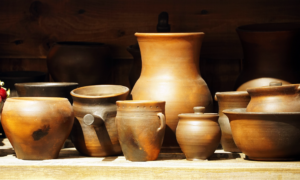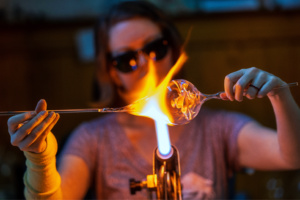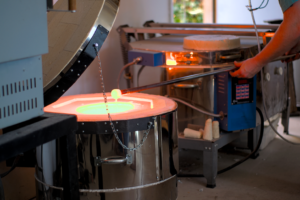If you are considering taking the next step on your pottery or ceramics practice and acquiring a kiln, the very first thing you should know is that gas and electric kilns are the most common types of technologies preferred for homes and workshops. These types of kilns vary not only in the source of energy to achieve the desired temperatures, but they can also vary in the finished results. Let’s review which one you should buy in this gas kiln vs electric kiln article.
First of All: Consider you goals
Before we start the gas kiln vs electric kiln subject, we need to talk about considering your goals.
It is very common to come up with many questions when searching for the right kiln. Which one should I buy? A gas kiln or an electric one? How would the differences show up in my work? How much is a gas kiln? And an electric one? Which is the best one for my purposes?
The best answer to many of these questions could be ‘choose the right one for your goals and artistic aspirations’, but, as we will see, you should also consider the scopes of each type of kiln, that is, you should also account that it is very important to know the main characteristics and differences between these two, in order to make the best decision while considering your own goals, needs and tastes.
Many workshops started by using wood and some continue to do so, given that real fire, the interaction of ash with the pieces and even the smell of wood interest artists and potters in their creative processes, nonetheless the challenges and costs of that practice have been replaced by the easiness of use, efficiency and functionality of gas and electric kilns.
Gas Kiln: Main Features
Gas kilns are one of the most widely used types of pottery and ceramic kilns, since they can reach high temperatures very quickly and they allow artists to adjust the amount of air flow to the interior, so temperature and flame modulation is achieved. This helps and invites artists to experiment with different temperatures and firing times so they can obtain interesting results.
- Temperature features
As we said, high temperatures can be reached and maintained very quickly, so pottery and/or ceramic pieces can be transformed into durable works of art in a matter of minutes.
Modern gas kilns often offer inverted flame technology, which ensures temperature to be homogeneous on every surface inside the kiln and that every creation has the best quality.
Inverted flame kilns also use less gas when compared with traditional direct flame kilns, so they represent an opportunity to invest in energy efficiency. But this naturally comes with higher prices, hovering around $10,000 to $18,000 USD.
The ability to modulate the temperature and flame of your firing environment that gas kilns offer has a direct impact on the quality of your fired pieces. This environment or atmosphere that is created usually as part of the creative process of artists affects both the glaze finish and texture of your clay bodies.
Kilns that offer the ability to reach very high temperatures make them especially good when firing porcelain and stoneware.
- Beware of your workspace
The majority of kilns that are designed to be fueled by gas utilize propane or natural gas, and they can be reasonably economical to acquire, install and use. To acquire a kiln that is fueled by gas you should consider the place where it will be located, as you will need to get permissions and inspections.
Installation of vent and gas lines, as well as the location of the hood, must be approved by codes and regulations that vary from one place to another. For the safety of users, gas cylinders, or wherever the source of propane or natural gas is located, must always be kept away from the kiln or any heat source. That is why the regulation protocols inspect the places where installation of vent and gas lines are going to be located.
For this reason, the easiest way to assure that you can install a gas kiln and take your creations to another level is to consult and let yourself be advised by a technician, such as the experts that accompany the processes of acquiring, installing, and maintaining kilns in optimal conditions.
- Gas Kilns adjust to your budget
Depending on the size of the kiln, the technologies that allow temperature homogeneity and modulation, the ease of approving installation regulations and, of course, your budget, gas kilns can be more or less economical.
Now, let’s see what electric pottery kilns can offer.
Electric pottery kiln: Are they any better?
Kilns that use electricity as an energy source to reach desired nice and steady firing temperatures were developed in the 20th century. They arose as a result of the search for new ways of heating during the industrial revolution and evolved into many designs depending on the desired objectives, such as producing ceramic or pottery objects, tiles, bricks and so on.
- Its interior allows temperature control
As their name suggests, electric kilns use an electrical current to produce firing temperatures. There are many materials that could work for an electric kiln to insulate, withstand and control the extremely high temperatures required for firing. Usually, the interior part of these kind of kilns are made from a soft, porous, and very insulating brick.
All along the inner walls of an electric kiln are special electric resistors or coils made of one type of alloy capable of generating the high temperatures. When turned on, you can adjust the temperature very easily, so that the electric current would heat the coils more or less according to your taste, producing a very homogeneous heated environment, perfect for your masterpieces.
- Pay close attention to voltage
Kilns that are designed to be powered by electricity must be adapted to the electrical system in which they are going to be installed and used. Most electric kilns are wired for 240-volt or 208-volt power systems and vary on required amperage according to size, normally from 9-amp to 56-amp.
But this is usually very easy to figure out, as residential areas are typically wired for 240-volt service, while industrial buildings and schools are wired for 208-volt service. So, if you are in any of these cases your electric kiln should be matched to the correct voltage.
As for voltage, amperage must be taken into account. Homes are usually wired with 100-amp service. So, for example a kiln rated to draw 56-amps should be in a circuit that provides at least 68-amps, because the kiln´s power draw will fluctuate during firing.
- How much is an electric pottery kiln?
Electric kilns are very popular because they offer safety, relatively low costs, ease of use and offer the ability to fire a wide range of materials. So, how much is a pottery kiln?
As we have said, it varies from their power source to size and technology. You can set up a nice electric kiln for around $1,000 USD. Or you can acquire a very powerful kiln for less than $9,000 USD.
It goes back to the first questions. What are your goals? As an artist. As a potter or ceramist. As a creative person. What would happen if you asked your hands?
This is not a gas kiln vs electric kiln fight, this is more like a comparison between both of them. This two types of kilns have their own attributes. Now, depending on your needs, you only need to choose the one that fits you better.






